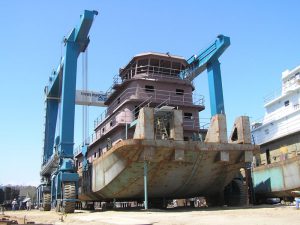
Metal Shark acquires Horizon Shipbuilding assets
JUNE 11, 2018 — Metal Shark, Jeanerette, LA, has acquired the assets of Horizon Shipbuilding, Bayou La Batre, AL, which has operated under Chapter 11 bankruptcy protection since October 24, 2017. The

JUNE 11, 2018 — Metal Shark, Jeanerette, LA, has acquired the assets of Horizon Shipbuilding, Bayou La Batre, AL, which has operated under Chapter 11 bankruptcy protection since October 24, 2017. The

MAY 6, 2017 — Coast Guard response and incident management teams recently coordinated with T & T Marine Salvage and G & H Towing to prevent a disabled ATB tug and barge
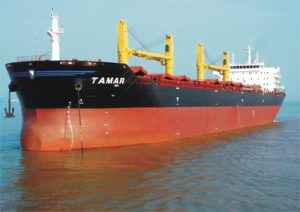
APRIL 24, 2017 — The U.S. Coast Guard is coordinating with the New York Air National Guard’s 106th Rescue Wing and the Canadian and Portuguese Coast Guards to provide a medical emergency
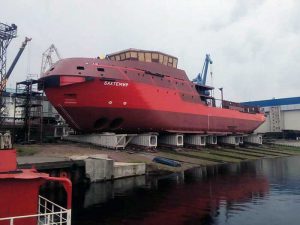
APRIL 10, 2017 — Russia’s Nevsky Shipyard is currently fitting out the fourth in a series of four MPSV12 design multipurpose, shallow draft, tug/salvage vessels. The 79.85 m by 17.36 m Arc

NOVEMBER 28, 2016 — The 97th session of the IMO Maritime Safety Committee (MSC 97) was held at IMO headquarters in London, November 21 to November 25. As ever it produced a
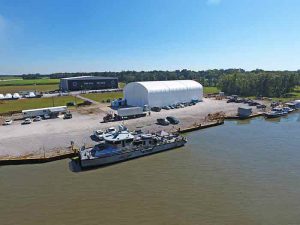
NOVEMBER 22, 2016 — Jeanerette, LA, based shipbuilder Metal Shark reports that an expansion project is now underway at its waterfront shipbuilding complex in Franklin, LA. To accommodate increased production needs, Metal
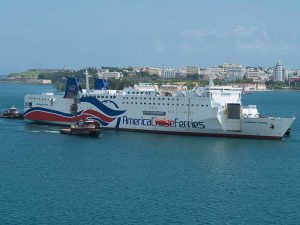
AUGUST 21, 2016 — The cruise ferry Caribbean Fantasy was moored safely Saturday at Pier 15 in San Juan Harbor. Salvage and fire fighting teams boarded the vessel Friday to assess the
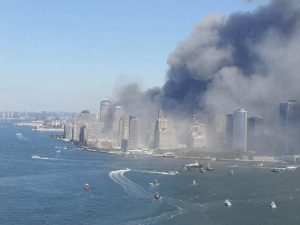
Obligation, vigilance, and perseverance are among the professional qualities of the merchant mariner. Whether one attends a maritime academy, as I did, or comes up through the hawsepipe, in seagoing service mariners learn and practice the ethos of care to crew, ship, and the environment. Mariners are supposed to display those qualities in spite of cold, or rain, or discomfort–one of my strongest memories of the academy is being on lookout, freezing, wearing all my jackets. Mariners are supposed to be ready, to be watchful, to put together skills and equipment and to balance paradox and contradiction to make a successful voyage.
The New York Harbor community combined all these unique attributes on 9/11, evacuating hundreds of thousands of commuters and residents of Lower Manhattan to Staten Island, to New Jersey, and elsewhere in New York City in an improvised fleet of boats: tugs, dinner boats, tour boats, private vessels. Over the course of those hours, boats made trip after trip across the harbor. Then, as the number of evacuees from Manhattan tapered off, the boatlift shifted to transporting responders and supplies to the island, an operation that continued for several days. They accomplished the largest water evacuation in history without planning, without practice—and without accidents.
What made this possible? To find out, my coauthor Tricia Wachtendorf and I talked with boat operators and waterfront workers, piecing together their stories for our book American Dunkirk: The Waterborne Evacuation of Manhattan on 9/11. Foremost was a spirit of service and a duty to rescue that is characteristic of the maritime community. Law and tradition require a mariner to come to the aid of a person at sea in danger of being lost. On 9/11 mariners widened the compass of their obligation to include the people who were queuing up at the shoreline.
The participants in this evacuation saw themselves as part of an active maritime community. Everyone knew everyone else, they said. They knew each others’ boats, and personnel were always moving from company to company, creating a strong network of acquaintance. Even though the commercial setting could sometimes be highly competitive, there were also habits of cooperation: any company might need help from any other in an emergency. It’s almost a rule in the disaster field that the planning process is more important than the plan itself. Responders have to become familiar with each others’ capacities, resources, and limitations. The years of interaction and familiarity were actually a planning process for urban disaster management, though they didn’t know it.
Mariners lead lives of paradox. GPS provides fabulous accuracy, but the prudent mariner is still reminded to check it by other means. Some mariners have attended disciplined and hierarchical academies where they live a regimented lifestyle while also learning Bridge Team Management, to adopt proper communications skills that short-circuit the intimidation of hierarchy. They operate in a complex web of maneuvering rules, which also contain a rule that prescribes that the rules should be broken when they’re not working. Often their information is ambiguous, as with weather, so they are sensitive to margins of error. In this complex milieu, mariners are always making judgments about safety, speed, and efficiency. These judgments abounded on 9/11.
They carried passengers on boats not certified for that. In some cases, they exceeded boats’ passenger capacity. Boat operators said they didn’t do this recklessly, but looked at the boat’s performance, the distribution of additional weight, and the demands of the immediate crisis. Certainly the usual margin of safety was narrowed in this event both with respect to capacity and to navigation. In some areas around the harbor the dust was so thick that visibility was zero, but they continued on. “Radar, don’t fail me now!” recalled one captain thinking as he approached the entrance to North Cove. Sometimes, boat captains took on bystanders to assist in embarking evacuees or in handling lines. Boats used piers they were unaccustomed to, or that weren’t designed for passengers, and had to jury-rig gangways because of the different heights. The captains were careful, using their experience and judgment to know how much they could push the boundary of risk. Other rules were slackened. A Coast Guard officer authorized fueling without permits. Two harbor pilots took golf carts to move supplies. The main thing was that when they pushed the limits, they were thoughtful, weighing the risk as experience has taught them.
Sometimes older technologies are more adaptable than modern ones. A break-bulk ship can work cargo anywhere, but a container ship, not so much. Efficiency sometimes erases adaptability, but disasters remind us of the importance of older tools and technologies, such as radio. Certainly there are tools to help the modern disaster manager: satellite photography, robotics, drones. But a lot of disaster management is old-fashioned work: moving things and people, staging equipment, organizing activities, talking on the phone. Probably the exemplar of this principle during 9/11 was the John J. Harvey, a retired fireboat that had been bought and restored by a group of enthusiasts. On the morning of September 11, the group boarded the Harvey and got underway first just to see what was happening, then they moved some evacuees, but then the Harvey’s real talent became obvious: the capacity to pump a lot of water. That capacity, left over from now-ancient days of wooden piers and warehouses and stacked-up flammable cargoes, was just what was needed to charge the fire hoses now substituting for the destroyed infrastructure at Ground Zero. Even in normal times, the Harvey demonstrated the qualities of prudence and vigilance. One of her owners, a retired fireboat captain, insisted they always have some usable firehose on hand, just in case.
Of course, there were challenges. The era of deep-draft commercial maritime use of much of Lower Manhattan has long since past. The waterfront had few good locations for the boats to embark passengers and lacked critical shoreside infrastructure, such as bollards or cleats, to tie boats to. Meanwhile, the smooth stone surface of the Battery Park seawall threatened to damage boats that were coming alongside. The sailboat Ventura, for example, could not tie up there because of being buffeted against the wall. “We’re going to have a boat that’s full of matchsticks and it’s going to sink,” said the captain. Even the durable Harvey got “quite a battering.” Some boats tied up to trees to hold steady for taking on evacuees. In other instances there was too much infrastructure, some of it in the form of fences and ornamental ironwork. Several participants in the evacuation reported simply cutting down the fences to clear a path for the evacuees.
The boat operations demonstrate what we have seen in many disasters: the importance of improvised, unscripted activities, and the importance of new groups, organizations, and networks. In spite of a widespread desire to “command and control,” that is not possible in an unfolding community-wide disaster. Most people are rescued by bystanders, for example, often well before formal responders arrive, which shows that there is always a grassroots dimension to disaster management. 9/11 maritime activities took place all around New York Harbor. No one could have full “command” of these activities, where needs were being identified and handled in an organic way through a growing network. The Coast Guard took a coordinating but not a commanding role. They wisely made no effort to take over the entire operation, recognizing that they needed to let it unfold. And there would be no way to command activities that were happening at Liberty Landing, or at Weehawken, or at Highlands, a 17-mile transit from Manhattan, where they were all dealing with their own needs of sorting passengers, decontaminating people, and offering comfort and bottles of water.
The 9/11 boat operations offer some insights for urban disaster management and resilience, organizations, and communities. Key features of resilience are redundancy, substitutability, and mobility. Some vessels can operate even if others are out of service. Boats are a mobile resource, easily moved around as needed. If some facilities are damaged, others may be available or can be improvised on short notice. Some vessels of more rugged construction served as floating piers, so that other vessels of lighter design would not be damaged against the seawall. Vessels are connected by VHF radio—nearly always available– and vessel movements are organized not by a flowchart or a rigid command structure but rather by a nautical chart and the mariners’ operational knowledge of that area: its laws, regulations, and customs. Public officials in waterfront cities should look closely at the different transport modes available. In particular, emergency managers and urban planners and engineers should work much more closely together to identify needs and resources.
That’s the key. People, groups, and communities share what they know; identify what they need; and connect to others. The maritime operations on 9/11 are an example of principles that extend to other settings. In situations as diverse as U.S. wildfires to the Fukushima tsunami and nuclear plant catastrophe, people have built new networks and improvised with whatever is available. A resilient disaster response depends on deep knowledge of a place, memory, gathering resources, and finding substitutes. These are the pieces that people can assemble creatively and strategically to manage a disaster.
You can view a list of the vessels and operators that lent their support on 9/11 at www.fireboat.org/911_rescue_boats.php
James Kendra is a graduate of Massachusetts Maritime Academy and a former merchant marine officer. He is Director of the Disaster Research Center at the University of Delaware.
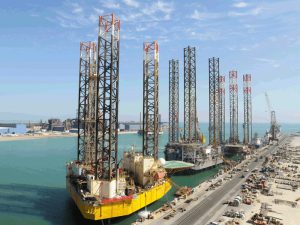
OPEC’s December decision to maintain oil output may not be doing any favors for U.S. shale producers, but continuing investment by national oil companies around the Arabian Gulf is underpinning a wide range of offshore-related projects and creating opportunities for regional shipyards.
There has, of course, been a sharp downturn in charter rates—the world’s largest energy firm Saudi Aramco, for example, told suppliers including Offshore Support Vessel (OSV) operators earlier in the year that it expected cuts in rates of 20-30%. Many regional OSV owners are under serious pressure.
But while shipyard prices are also sharply constrained, there is no shortage of work. Oil producing countries are geared to pumping as much oil as possible and making the most of the opportunity to grow their market share. Both Saudi Aramco and the Abu Dhabi National Oil Company (ADNOC) have revealed that they have no plans to cut back on exploration and production although, to be fair, the Saudi energy company has stopped exploring in the Red Sea for the moment.
Both oil companies have huge capex programs, however. ADNOC has plans to raise oil output by a quarter, to 3.5 million b/d by 2018. The company plans to spend close to $100 billion over the next four years, it revealed last May. More than $60 billion will be spend over the next two years. A significant proportion of the money will be channelled offshore in vast oil fields that lie in shallow water. The oil-rich Emirate is developing some of its offshore reserves by creating artificial islands that provide a cheaper means of production for long-life fields than chartering jack-ups.
With relatively low production costs, Middle East oil producers are less vulnerable to low prices than almost everyone else. The continuing drive to explore and develop more reserves has been a major catalyst in the drive by regional shipyards to target the offshore sector. Heavyweight repair yards including ASRY in Bahrain, Drydocks World Dubai and N-KOM in Qatar have all developed substantial revenue streams from the offshore sector in recent years.
Now, several new yards are targeting the offshore market. The family-owned Zamil Group officially commissioned a new shipyard built on reclaimed land last April. The 2.5 million ft2 facility has been designed not only to build and repair the group’s own vessels—it has a fleet of 76 vessels, mostly OSVs—but also to work on other ship- and offshore-building projects for third parties.
A few miles down the coast, Dammam Ship Repair Yard is also gearing up to take on more business in the offshore sector. The yard has already undergone a significant upgrading under ownership of the Al Blagha group, with two floating docks of 22,000 tonnes and 10,000 tonnes lifting capacity refurbished and brought back into class. Buildings, workshops and yard infrastructure has also been overhauled and upgraded.
Now though, yard management is targeting international offshore operators working in Saudi waters. Mobile repair teams from the shipyard have been deployed on rigs offshore, carrying out a range of projects. Meanwhile contractors including Ensco, Rowan, Noble and Seadrill all carried out jack-up rig repairs, upgrades and modifications during 2015.
Elsewhere in the Gulf, Damen Shipyards Sharjah is also eyeing the offshore sector. The new facility, which is a joint venture between the global shipyard group and locally owned Albwardy Marine Engineering, is a newbuilding and repair yard capable of handling offshore support vessels, tugs and workboats of various types. Its facilities include a Rolls-Royce ship lift capable of handling vessels up to 394 feet, 4,000 feet of quay for alongside repairs, and eight dry repair berths.
 BUSY AT GRANDWELD
BUSY AT GRANDWELD
This past year, Grandweld completed the construction of 17 vessels. The shipyard’s latest projects include advanced crew boats, dive maintenance and support vessels, and work crane boats for a who’s who of Middle East energy firms and offshore contractors.
Grandweld, which has been operating from its Dubai base since 1984, specializes in vessels custom built to conduct complex operations in the region’s challenging offshore environment.
These range from three recently delivered work crane boats for Kuwait Oil Company – optimized for duties such as heavy lifting, oil-pollution control, SPM hose handling, and supply to remote areas – to two modified 42-meter-long crew boats (FNSA-3 and FNSA-4) for Fujairah National Shipping Agency. The latter vessels are capable of speeds in excess of 30 knots and customized to execute operations such as security duties, fast transportation of offshore personal and cargo, and the rapid supply of fuel and freshwater.
“The Middle East is a unique environment, with unique challenges and opportunities,” says Jamal Abki, General Manager Grandweld Shipyards. “We have a history of producing vessels that excel here. We use that understanding to continually enhance our offering, while building new relationships with international clients who can benefit from our expertise when it comes to meeting their own exacting requirements.
“Our integrated proposition is efficient, flexible and modern, while our in-house engineers and project managers are world class. In addition, we invest heavily in research and development to enhance our own designs, as well as using respected external designers when desired. This ensures our vessels are leading the way in operational efficiency, reliability and performance – something the industry clearly appreciates.”
Further noteworthy deliveries over the last months include three 34.3m aluminum crew boats to Jana Marine Services, a 50m Dive Maintenance & Support Vessel to Abu Dhabi National Oil Company (ADNOC), and the 42m crew boats Stanford Volga and Stanford Niger, which are capable of carrying 83 people at speeds of 25 knots.
“It’s an exciting time for the business, and our customers,” concludes Jamal Abki. “As the offshore trend points towards more optimized, complex vessels, our knowledge and experience allows us to respond with advanced newbuilds that deliver added performance and competitiveness for our clients.
“We’re now looking forward to building on our leading market position over the space of the next 12 months, and beyond.”
Meanwhile, Gulf ship repairers are all cautiously optimistic on potential business from Iran. However, legal experts specializing in sanctions are urging the utmost caution. The latest diplomatic fall-out between Saudi Arabia and Iran will certainly not have helped.
NEW DESIGN FROM ROLLS-ROYCE TARGETS U.S., TOO
Offshore operators in the Gulf of Mexico are among those being targeted by Rolls-Royce as it introduces the first in a series of new mid-range offshore vessel designs specifically developed to meet the requirements of companies working in a low capex era. The UT 7217 is a DP2 anchor handling tug supply ship with a bollard pull of 100 tonnes which can be raised to 130 tonnes without any fundamental design changes.
Jan Emblemsvåg is Senior Vice President of Ship Design at Rolls-Royce. He says that the company’s analysis has revealed that there are already more than 600 vessels in this range which are more than 25 years old. This could be the first sector of the offshore market to generate new demand, he believes. There will inevitably be a replacement requirement at some point, he says, and the UT 7217 has been designed with operators’ likely future requirements specifically in mind.
Although the design has been developed to incorporate as much flexibility as possible and will be capable of worldwide deployment, specific offshore markets which Rolls-Royce has identified besides the Gulf of Mexico include the Middle East and the South China Sea. Vessel price will of course depend on region and shipyard, but Emblemsvåg reveals that initial indications from some Far Eastern yards lie in the $17 million to $18 million range.
The design has been developed to compete effectively with existing ships in the sector. Bollard pull is greater than the typical 70-80 tonnes, for example, and deck area – at 500 square meters – is more than the usual 450-460 square meters. There is more cargo capacity than is usual and the vessel has a launch and recovery system.
With cost constraints in mind, Rolls-Royce designers have chosen a diesel mechanical propulsion system which comprises two medium-speed C25:33L9P CD diesels of 3,000kW each, driving two US305 controllable pitch azimuth thrusters with 3.2 meter diameter propellers in nozzles. Each engine drives a shaft generator and fire pump for fire-fighting duties. There are two independent 400kW generating sets providing electrical power and two 590kW bow thrusters.
Operating flexibility will be aided by the SPS notation which will enable the vessel to carry up to 12 additional personnel besides the crew. There are 29 cabins giving a maximum of 40 on board. This means that the ship can be deployed in a wide range of tasks, including cargo supply, anchor handling, ROV operations, safety standby and maintenance and repair.
The competitive price indications are based on a Rolls-Royce equipment package including the main two-drum hydraulic winch with 200-tonne heave and 250-tonne brake rating. They also assume the diesel mechanical propulsion system. However, Emblemsvåg is well aware that some OSV operators may wish to specify other equipment and possible alternative propulsion arrangements such as a diesel-electric set-up. These, he says, can be accommodated but will obviously have an impact on price.
Other mid-range offshore vessel designs are currently being worked on by Rolls-Royce naval architects. They include a larger 150-tonne anchor handler likely to be introduced later this year. A mid-range subsea construction vessel design is also on the drawing board, intended for waters where breakeven production costs are relatively low and where energy companies will be focusing whilst the oil price stays down.
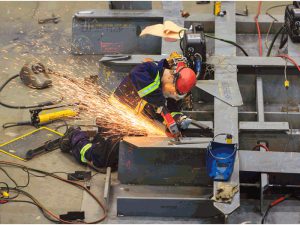
Oil and gas E&P generates billions of dollars worth of business annually for shipyards in the form of newbuilds, conversions, and ongoing repairs and maintenance. With the downturn in oil, however, much of that business has dried up and forced shipyards that depend on the oil patch to rethink their strategy. Many are repositioning themselves to pursue other markets or are undertaking capital investments in their facilities to be more efficient and competitive.
There’s no better example than VARD Holdings, one of the world’s largest shipbuilding groups, whose portfolio is heavily focused on offshore oil and gas. Amid losses of NOK1.29 billion (about $148 million) VARD said last month it would preserve its core expertise and skilled employee base and use its existing shipyard capacity until an eventual recovery in its core market. Among the areas it was pursuing were the offshore wind and aquaculture markets. It will also work more closely with its major shareholder, Fincantieri, to support the cruise vessel and offshore patrol vessel sectors.
NORTH AMERICAN SHIPYARDS INVEST, DIVERSIFY
While operators in the Gulf of Mexico have cold stacked many of their vessels, Galliano, LA-based Edison Chouest Offshore, one of the world’s largest offshore support vessels operators, announced last month that it would invest $68 million in opening a new shipyard in the Port of Gulfport, MS. The shipyard, called TopShip, LLC, will operate at the former Huntington Ingalls Composite Facility, which was acquired by the Port of Gulf Port last March.
The new yard was made possible through an incentive package from the Mississippi Development Authority that would help bring TopShip to the port and create over 1,000 jobs, according to Jonathan Daniels, Executive Director and CEO of the Mississippi State Port Authority—the job creation would prove a significant boost to the local economy.
Lawmakers approved an $11 million package through the Mississippi Major Economic Impact Authority—with $10 million going to discretionary funds and $1 million allocated for workforce training. Additionally, the Port has said it would provide $25 million in Katrina-CDBG funds for infrastructure improvements.
ECO already operates shipyards in the U.S. and one in Brazil: North American Shipbuilding, Larose, LA, LaShip, Houma, LA, Tampa Ship, Tampa FL, Navship in Brazil, and Gulf Ship which is also in Gulfport. Most of ECO’s fleet has been constructed at one of its yards.
Having been born in Mississippi, Gary Chouest, ECO President and CEO expressed his gratitude towards the state for the opportunity to provide quality service to its customers, and help the community thrive.
“We are indeed excited about the opportunities to grow TopShip in a business friendly state, one where we can reach out into the community to recruit various skill sets, developing a quality workforce that will allow TopShip not only to compete locally, but also globally,” said Chouest. “With the help of the state of Mississippi, we will modify our TopShip facility to become one of the safest and most efficient shipyards in the nation, building Chouest pride for our employees.”
Mississippi’s VT Halter Marine, too, has seen how investing in its facilities can help business. Over the last 10 years, VT Halter has invested over $100 million to upgrade its three facilities in Mississippi. This includes expanding beyond the newbuild business with a $13 million investment in a new drydock and repair facility back in 2015, the addition of a blast and paint facility; and the purchase of a 76,000 ft2 climate-controlled warehouse.
The investments have not only allowed growth into the repair business, but also made VT Halter Marine more efficient in its newbuild projects, enabling it to meet the growing demands of the increasingly popular Articulated Tug and Barge (ATB) market. Most recently, VT Halter completed the second of two 250,000 bbl ATB units for Bouchard Transportation (see this month’s CEO Spotlight); and currently is preparing the delivery of the second of two 130 ft, 6,000 hp ABS class ocean towing ATB tugs for Bouchard.
VT Halter Marine is also currently building two 2,400 TEU LNG-powered combination ConRo ships for Crowley Maritime Corporation’s liner services group. El Coquí and Taíno will operate in the Jones Act trade between Florida and Puerto Rico and will offer a 38% reduction in CO2 emissions per container. The ships will be delivered by VT Halter Marine in 2017.
Another yard that has benefited from the use of Liquefied Natural Gas (LNG) as a marine fuel is Conrad Industries. The last few years has seen Conrad Industries, Inc., Morgan City, LA shifting its business approach and diversifying its portfolio—among the shipbuilder’s offerings, it builds tugs, ferries, ocean tank barges, liftboats and specialty barges. In 2015 the yard’s orderbook received a much-needed boost with new construction contracts, including the history-making construction of the first LNG bunker barge for the North American market.
Currently under construction at Conrad’s Orange Shipyard, Orange, TX, the 2,200 m3 capacity bunker barge is being built for WesPac Midstream LLC. Designed by Bristol Harbor Group, Inc., Bristol, RI, and built to ABS class, the barge when delivered later this year will serve TOTE’s Marlin class containerships—Isla Bella and Perla del Caribe, both built at General Dynamics NASSCO. Those LNG-fueled ships are already operating in the Jacksonville to Puerto Rico trade.
It was also certified by GTT to construct the special LNG containment system on the LNG transport bunker barge.
 The shipbuilder has also broadened its offerings further with the expansion of its Deepwater South facility in Amelia, LA. The 52-acre site has enabled Conrad to build large articulated barge units. Currently there are eight tank barges under construction at Deepwater South—ranging from 55,000 bbl to 83,000 bbl capacity.
The shipbuilder has also broadened its offerings further with the expansion of its Deepwater South facility in Amelia, LA. The 52-acre site has enabled Conrad to build large articulated barge units. Currently there are eight tank barges under construction at Deepwater South—ranging from 55,000 bbl to 83,000 bbl capacity.
Conrad says that Deepwater South will undergo a wide range of improvements this year including the addition of a new fabrication and assembly building—which will allow for the uninterrupted construction of hull modules year round; and a new Panel Line Building—expected to begin operations this April. The Panel Line Building will be equipped with an automated welding system, a stiffener fitting gantry to automate the fit-up of stiffeners on the panels, and an 8-headed automated stiffener welder—allowing for the shipyard to process 350 tons of steel per week.
THREE NEW FAB BAYS
C&C Marine and Repair, Belle Chasse, LA, is focusing on increasing efficiencies to maintain its competitive advantage. The yard recently added three new fabrication bays giving C & C an additional 115,000 ft2 for the construction of boats and barges; and a fabrication area of 230,000 ft2.
Over the next few months, the yard plans to order two additional transporters (it currently has two capable of moving 600 tons) with a capacity of 830 tons, bringing the total capacity of its transporters to 1,430 tons. This, says New Construction Manager Matthew J. Dobson, will create new opportunities for the yard, and enable C & C to begin taking orders for the fabrication of new 30,000-barrel barges and allow it to transport larger vessels to land for repair projects and paint jobs.
The yard currently has 29 new construction vessels under contract including three 6,600 hp towboats, one 280 ft PSV, one 270 ft cutter head barge, sixteen tank barges and eight deck barges of various sizes.
EXPANDING INTO LARGER VESSELS
Back in 2014, Metal Shark Boats, Jeanerette, LA, was already a successful builder of aluminum vessels, but it had its sights on the construction of vessels up to 90 ft in length and larger, as well as expansion of its portfolio to include steel. It also signed a technology agreement with Damen that would allow it to build offshore patrol boats up to 165 ft in length.
With the development of the new shipyard in Franklin, LA, Metal Shark, now employs 230 workers between its boat yards, and is among the busiest boatbuilders in the U.S., currently producing a number of 38 ft, 45 ft and 55 ft Defiant class vessels and constructing large orders for the U.S. Coast Guard, U.S. Navy and multiple agencies across the U.S. It also delivered a sophisticated 75 ft multiple purpose port security fire boat to the Port of South Louisiana.
EYE ON THE CARIBBEAN MARKET
For St. Johns Ship Building, diversification of its portfolio and the markets it reaches will propel its next evolution. The small shipyard, which has been under private ownership since 2006, recently delivered the first Elizabeth Anne class of towing vessels to the Vane Brothers Company. The tug is the first in a series of eight the Palatka, FL-based yard is building for the operator. At press time the second vessel was in the water and the third was about to be launched.
St. Johns Ship Building’s yard sits along the St. Johns River—giving it the unique advantage of being on the East Coast with access to both the Gulf of Mexico and the Caribbean—and its because of its location St. Johns has been able to produce such a diverse portfolio. From OSVs to tugs (a new market for the builder), to coast guard vessels and cargo ships, St. Johns’ 100 acre facility and its 150 employees are at the ready to take on any project.
St. Johns Ship Building President Steven Ganoe says that because the yard doesn’t solely rely on the oil and gas market it has been able to keep business steady during the downturn in the oil and gas market.
Ganoe says the shipyard is keeping tabs on the Caribbean market to see how it develops in the wake of the easing of restrictions on Cuba travel—and determine how St. Johns can help meet any growing demand in that specific market. In the meantime, the shipbuilder continues to make improvements to its facility—having recently added an 18,000 ft2 assembly shop and a Messer CNC 80 ft table to help make production more efficient.
REBORN AS WORLD MARINE
Earlier this year it was announced that World Marine LLC—owned by the Teachers’ Retirement System of Alabama and the Employees’ Retirement System of Alabama—had bought all of Signal International’s assets including its full service and heavy fabrication facilities in Mobile, AL and Pascagoula, MS.
According to the Chapter 11 plan of liquidation, World Marine is seeking to become a leader in the ship repair and ship construction market.
World Marine assures that its experienced team—led by Dick Marler—can handle all types of vessels, but the company will place a high focus on new construction, and the repair and conversion of ocean going vessels and offshore drilling rigs—serving the energy, government and commercial marine markets.
World Marine’s construction and repair facilities include three drydocks—a 22,000-ton Panamax class, a 4,200-ton, and a 20,000 MT heavy lift. The company says its future plans include pursuing the emerging LNG market for the construction of bunker barges and transfer vessels.
NEW DRYDOCK AT COLONNA’S
A decade after the American Civil War ended, Colonna’s Shipyard was founded by Charles J. Colonna. Now, 140 years later, the yard continues to operate and develop with the times.
The shipyard currently occupies over 100 acres of land in the Berkley section of Norfolk, VA, and has water access to over 3,000 ft of vessel berthing space and a lift capacity to accommodate vessels up to 850 long.
Colonna’s is also home to the largest Travel lift in the U.S.—with a capacity of 1,000 metric tons.
As part of its future improvement plans, Colonna’s expects to purchase an additional 25 acres across the street from its main entrance, and add a new floating dry dock.
A few months ago, the Governor of Virginia, Terry McAuliffe, announced that the yard would undergo a significant expansion, with Colonna’s investing over $30 million to expand its operations in the City of Norfolk. The expansion would include a new larger drydock, dredging and improvement work to the channel and bulkhead work, and the creation of 51 jobs to the area.
The new floating drydock, which will be named the Charles J., will have a lifting capacity of 11,500 metric tons, an overall length of 595 ft and an inside width of 108 ft. The Charles J. is expected to be fully operational in early 2017 and will accommodate a variety of vessel types including ferries, tugs, barges, containerships, OSVs and several type of government vessels.
Colonna’s CEO Tom Godfrey, said the capital investments would “allow Colonna’s to continue to provide quality services to both commercial and government customers throughout the region.”
 NEW DRYDOCKS, AT BAE, DETYENS, BAY SHIPBUILDING
NEW DRYDOCKS, AT BAE, DETYENS, BAY SHIPBUILDING
Meanwhile, South Carolina-based Detyens Shipyards recently took delivery of its new floating drydock. Built by Corn Island Shipyard, Grandview, IN, the 400 ft x 108 ft drydock will enable the yard to provide a more cost-effective service to smaller tonnage vessels.
According to Detyens, in the past, smaller vessels would have to piggy back in the yard’s larger graving dock—now with the addition of the smaller dock, it can provide drydock services to vessels up to 11,000 DWT. The new dock sits along the yard’s F Pier, which recently underwent upgrades that included the addition of shipyard services, additional lighting, and dredging of 30 ft.
On the U.S. West Coast, BAE Systems is investing $100 million to build and install a second, larger drydock at its San Diego shipyard. Currently under construction in China, the 950 ft drydock will have a lifting capacity of 55,000 long tons and is expected to support the expansion of the Navy ships homeported in San Diego, which are expected to increase by 20 from 60 to 80 by 2020, according to BAE’s Director of Communications, Karl Johnson. BAE Systems is among the leading providers of maintenance and modernization services of the U.S. Navy.
Portland, OR, Vigor Industrial has been aggressively growing its business through the acquisition and merger with several other regional shipyards, including Kvichak Marine Industries, Seattle, WA.
In 2014, Vigor’s Portland yard began operating its new $50 million drydock, the Vigorous. It has been consistently booked since, supporting hundreds of jobs and attracting work that could not have previously be performed in the region, according to Vigor’s Athena Maris.
 Vigorous, with a lifting capacity of 80,000 long tons, is 960 ft long with an inside width of 186 ft and has taken on several repair work projects including the repair work on cruise vessels, and most recently, this past summer, on repair the hull of the multipurpose icebreaker on charter for Shell, the MSV Fennica.
Vigorous, with a lifting capacity of 80,000 long tons, is 960 ft long with an inside width of 186 ft and has taken on several repair work projects including the repair work on cruise vessels, and most recently, this past summer, on repair the hull of the multipurpose icebreaker on charter for Shell, the MSV Fennica.
The addition of Vigorous at the Portland yard, enabled Vigor to also reinvest in some of its existing assets. Specifically, Vigor was able to upgrade and transfer one of Portland’s drydocks to its Seattle facility. In Seattle, the drydock Vigilant will be used to perform repair work on the recently awarded Structural Enhancement Drydock Availability (SEDA) Projects. There, the U.S. Coast Guard cutters Bertholf and Waesche will both undergo significant structural enhancement work, system upgrades and maintenance.
Beyond that Vigor is placing capital investments efforts on its environmental stewardship—this includes working on a comprehensive storm water management system at its Portland facility and a shallow-water estuary to help increase the survival of young salmon and steelhead trout on their way to the ocean at its Seattle facility.
 On the Great Lakes, Fincantieri Bay Shipbuilding (FBS) parent, Fincantieri Marine Group (FMG), has invested more than $33 million in capital improvements to increase manufacturing capabilities at its facility in Sturgeon Bay, WI. FMG is currently in negotiations to acquire additional property adjacent to the shipyard to further expand its serial production capabilities.
On the Great Lakes, Fincantieri Bay Shipbuilding (FBS) parent, Fincantieri Marine Group (FMG), has invested more than $33 million in capital improvements to increase manufacturing capabilities at its facility in Sturgeon Bay, WI. FMG is currently in negotiations to acquire additional property adjacent to the shipyard to further expand its serial production capabilities.
FBS has completed its new Pipe/Outfitting Building & New Welding Center and added a new floating dry dock that has a total lift capacity of 7,000 long tons. The versatile dry dock can be sectioned off, with a 216 ft section and a 432 ft section.
It has completed the expansion of its Fabrication Building and has added a new Beveling Plasma Burning Machine, 200-ton Yard Transporter, IMG Micro Panel Line, and 1000-ton CNC Press.
Back in 2012, FBS added a 45 ft x 47 ft “megadoor” to the south end of its Fabrication Building 311 to allow larger vessels to be built indoors and moved outside for launching and a Manitowoc 300-ton capacity Model 2250 Crawler Crane.
FBS employs 600 to 800 full-time shipyard professionals and expands its workforce to 1,100 to 1,200 using temporary and contract workers during the Winter Fleet repair season.
FBS currently has under construction six tugs and seven barges of ATB design. Accompanying photo shows the ATB tug Barbara Carol Ann Moran and the ocean tank barge Louisiana at the shipyard. As we reported back on February 22, the shipyard has 14 vessels undergoing a wide range of repairs and repowerings for the Great Lakes Winter Fleet.
SAN DIEGO BOATBUILDER GETS BIGGER, GREENER
Vigor, however, isn’t the only shipbuilder looking to help the environment. San Diego based Marine Group Boat Works will soon break ground on a $1.5 million green initiative that will see the yard install a solar panel system compliant with the state of California’s Solar Initiatives.
The addition of solar power comes during one of the company’s most exciting periods, says Marine Group Boat Works’ (MGBW) Leah Yam. MGBW, which has two yards in San Diego and one in San Jose del Cabo, Mexico, recently completed a $2.5 million renovation to its deepwater floating docks system, and will install the final set of docks this spring—making it fully ready for in-water repairs on vessels up to 420 ft in length.
Among MGBW’s most recent repair and retrofit projects is the $19 million refurbishment of the Golden Gate ferry M.S. San Francisco and the conversion of two high-speed aluminum Sub Chapter K San Francisco ferries for the Water Emergency Transportations Authority.
Beyond its repair business, MGBW is also making a dent in the new construction market. Since launching its new construction division in 2008, the shipyard has increased its employee numbers by about 195%, employing 185 workers. Currently, MGBW has five 60 ft aluminum dive boats under construction for the U.S. Navy—the contract calls for the construction of 16; and most recently delivered the first in a series of steel workboats to Japan—two additional boats are on their way, and twelve are on the production schedule, says Yam.
CANADIAN YARDS INVEST FOR NSPS
The end of 2014 saw the completion of Seaspan’s Shipyard Modernization project. Funded entirely by the shipyard, the $155 million project helped transform Seaspan’s Vancouver Shipyards into one of the most modern yards in Canada.
 The two-year project included the addition of four new fabrication buildings—housing a sub assembly shop; panel shop with panel line; block assembly shop; pre-outfitting shop; paint and blast shop; and Canada’s largest (300 tonne) permanent gantry crane.
The two-year project included the addition of four new fabrication buildings—housing a sub assembly shop; panel shop with panel line; block assembly shop; pre-outfitting shop; paint and blast shop; and Canada’s largest (300 tonne) permanent gantry crane.
The expansion was integral to meeting the newbuild project requirements for the Canadian Coast Guard and the Royal Canadian Navy.
Vancouver Shipyards is currently building the first Offshore Fisheries Science Vessel (OFSV) under the National Shipbuilding Procurement Strategy (NSPS) for the Canadian Coast Guard. The 208 ft x 52.5 ft OFSV will help support scientific and ecosystem research critical to the economic viability and health of the region’s marine environment. At press time, 30 of the 37 blocks of the OFSV were under construction.
Seaspan also invested an additional $15 million at its Victoria Shipyards, upgrading its facilities with the addition of a new operation center that, according to Seaspan, would help support testing, trails and commissioning new federal vessels.
At press time, there were nine vessels undergoing refits and drydock work at one of Seaspan’s yards—including the 94 ft Canadian Coast Guard vessel Siyay with is undergoing a nine-month midlife modernization refit.
Keeping the future in mind, Seaspan is also investing in its workforce. Seaspan employs 1,500 employees across its three shipyards—Vancouver Shipyards, Vancouver Drydock, and Victoria Shipyards.
In 2015, the shipbuilder received a Canada Jobs Grant to develop e-learning tools for its expanding workforce—the goal of the funding was/is to help ensure workers have a common understanding of the shipbuilding processes, practices, and protocols.
Seaspan also recently announced that it plans to invest $2 million over the next seven years to help support teaching and research in the University of British Columbia’s naval architecture and marine engineering programs.
At Irving Shipbuilding, Halifax, NS, Canada, the company’s $330 million capital investment plan is already paying dividends. Last September, it marked the start of production of the HMCS Harry DeWolf, the first Arctic Offshore Patrol ship (AOPS) for Canada.
The ship is the first of up to 21 vessels that will renew Canada’s combatant fleet over the next 30 years under the NSPS. Irving Shipbuilding has built more than 80% of Canada’s current combatant ships.
Current direct employment at Marine Fabricators in Dartmouth and the Halifax Shipyard is about 900. Over the next two years, the workforce at both sites is expected to rise to 1,600, with over 1000 directly employed on AOPS production. In addition, total employment at Irving Shipbuilding (all operations) is forecasted to rise to over 2,500 direct employees at peak production of the larger Canadian Surface Combatant vessels that will replace Canada’s current fleet of Halifax Class frigates.
To date, the modernization at Irving Shipbuilding and the AOPS contract have resulted in over $1 billion in spending commitments.
Meanwhile, one of the oldest shipyards in North America, Chantier Davie Canada Inc., Levis, Quebec, has taken its first steps in the Resolve-Class Auxiliary Oiler Replenishment ship project. The project involves the conversion of a containership into an Auxiliary Oiler Replenishment Ship that will be delivered to the Canadian Royal Navy in 2017.
It also recently completed the refit of four of Canada’s heaviest icebreakers, as well as a bulk carrier and is a pioneer in the construction of LNG-fueled ferries.